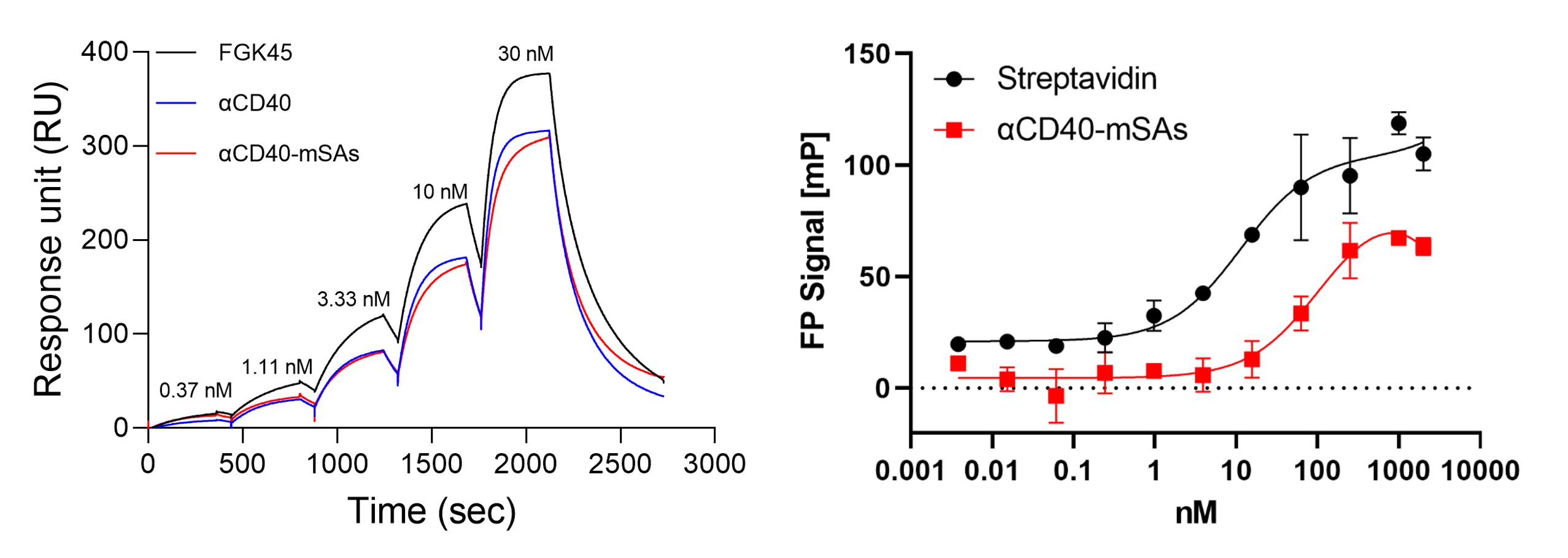Formulation and Delivery - Biomolecular
Category: Poster Abstract
(T0930-02-10) Engineered Anti-CD40 Agonist Antibody as a Novel Cancer Neoantigen Vaccines
Tuesday, October 24, 2023
9:30 AM - 10:30 AM ET
- DJ
Dahee Jung, MS (she/her/hers)
University of Illinois Chicago
Chicago, Illinois, United States - DJ
Dahee Jung, MS (she/her/hers)
University of Illinois Chicago
Chicago, Illinois, United States - SL
Steve Seung-Young Lee, Ph.D.
University of Illinois Chicago
Chicago, Illinois, United States - SL
Seung-Oe Lim, Ph.D.
Purdue University
West Lafayette, Indiana, United States
Presenting Author(s)
Main Author(s)
Co-Author(s)
Purpose: Somatic mutations in cancer cells lead to the expression of neoantigens that can be targeted by personalized vaccines. However, current cancer vaccines have shown poor clinical outcomes due to the lack of effective delivery methods. To address the issues, our study aims to develop a novel vaccine platform that targets dendritic cells (DCs) and delivers neoantigen peptides more effectively through the use of an anti-CD40 agonistic antibody expressing monovalent streptavidins (αCD40-mSAs). The agonistic anti-CD40 antibody will target and activate DCs, and the mSA compartment will allow the loading of two biotinylated payloads (e.g. peptides, proteins, RNAs) on each vaccine carrier (Figure 1 panel 1, neoantigen loaded αCD40-mSAs illustration). Our goal is to directly deliver neoantigen peptide-loaded αCD40-mSAs to DCs in draining lymph nodes (dLNs) via subcutaneous (s.c.) injection as a therapeutic cancer vaccine.
Methods: CHO cell-based recombinant protein production method was used to biosynthesize αCD40 and αCD40-mSAs. First, cloning vectors were reconstructed based on mouse IgG2a, incorporating the peptide sequences on the complementarity-determining regions (CDRs) of anti-mouse CD40 agonist antibody (clone FGK45) [1] and monovalent streptavidin [2]. Cloning vectors were transfected to ExpiCHO expression system to produce antibodies. Protein G column was used to purify the produced antibodies. SDS-PAGE assay was conducted to confirm the expression of mSAs in the light chains of αCD40. To evaluate the binding affinity of αCD40-mSAs to mouse CD40, surface plasmon resonance (SPR) was performed. Fluorescence polarization (FP) was used to confirm the biotin-binding property of the monovalent streptavidin compartment. Flow cytometry was employed to confirm the activation effects of αCD40 on bone marrow-derived dendritic cells (BMDCs) after 24h incubation. After subcutaneous (s.c.) injection on the mouse footpad, lymph nodes were retrieved, stained with a dendritic cell marker, and imaged using confocal microscopy to confirm the rapid transport of antibodies to the neighboring lymph node.
Results: The study successfully produced αCD40-mSAs, as confirmed by SDS-PAGE gel data showing the increased molecular weight of the light chain of αCD40-mSAs at approximately 40 kDa, indicating the expression of streptavidin monomer structure. Representative sensorgram plots (Figure 2, Left) showed dose-dependent response of the antibodies (commercialized αCD40, αCD40, and αCD40-mSAs) to the mouse CD40. Both αCD40 and αCD40-mSAs showed high-affinity binding to CD40 based on SPR analysis and had similar KD (equilibrium dissociation constant) of 12.3 and 12.7 nM, respectively. FP confirmed that FITC-biotin binds with αCD40-mSAs with 111.4 nM KD (Figure 2, Right). Flow cytometry confirmed that the activation markers, such as CD40, CD86, and MHCII, increased after 24h incubation of αCD40 with BMDCs. After collecting a popliteal lymph node (LN) at 15 min post-injection and staining for CD11c+ dendritic cells (DCs), we observed that subcutaneously injected αCD40 rapidly moved into the nearest draining lymph node and bound to DCs (Figure 3). It has been determined that over 44% of the CD11+ DCs' area in the draining lymph node colocalized with subcutaneously injected αCD40.
Conclusion: In conclusion, this study developed an effective cancer vaccine delivery platform using αCD40-mSAs to target DCs and deliver neoantigen peptides more effectively. The study demonstrated that αCD40-mSAs showed high-affinity binding to CD40, biotin-binding property, and a capability of BMDC activation. The study also showed that αCD40 rapidly moves into the nearest draining lymph node after subcutaneous injection. This study provides a promising strategy for delivering personalized neoantigen vaccines and enhancing their efficacy by using an effective carrier.
References: [1] US8361471B2
[2] Lim KH, Huang H, Pralle A, Park S. Engineered Streptavidin Monomer and Dimer with Improved Stability and Function. Biochemistry. 2011;50(40):8682-91.
Acknowledgements:This project was supported by NIGMS R35 GM142743 (S.S.-Y.L.).
The SPR analysis was performed by the Biophysics Core in Research Resources Center of University of Illinois at Chicago.
 Figure 1. Graphical Abstract illustrating the mechanism of action of anti-CD40 agonistic antibody expressing monovalent streptavidins (αCD40-mSAs) as an immunomodulating cancer vaccine
Figure 1. Graphical Abstract illustrating the mechanism of action of anti-CD40 agonistic antibody expressing monovalent streptavidins (αCD40-mSAs) as an immunomodulating cancer vaccine Figure 2. Representative SPR sensorgrams of commercialized αCD40 (FGK45), and in-house made αCD40 and αCD40-mSAs response to mouse CD40 protein (Left). The equilibrium dissociation constant (KD) were FGK45=8.4 (± 0.13), αCD40=12.3 (± 0.13), and αCD40-mSAs=12.7 (± 0.27) nM, respectively. FITC-biotin (20 nM) interactions with CD40-mSAs and streptavidin (as a positive control) from fluorescent polarization assays (Right). The calculated equilibrium dissociation constants (KD) for CD40-mSA and streptavidin were respectively 111.4 and 11.45 nM.
Figure 2. Representative SPR sensorgrams of commercialized αCD40 (FGK45), and in-house made αCD40 and αCD40-mSAs response to mouse CD40 protein (Left). The equilibrium dissociation constant (KD) were FGK45=8.4 (± 0.13), αCD40=12.3 (± 0.13), and αCD40-mSAs=12.7 (± 0.27) nM, respectively. FITC-biotin (20 nM) interactions with CD40-mSAs and streptavidin (as a positive control) from fluorescent polarization assays (Right). The calculated equilibrium dissociation constants (KD) for CD40-mSA and streptavidin were respectively 111.4 and 11.45 nM..jpg) Figure 3. Dendritic cell (DC)-targeting of anti-CD40 agonistic antibody. Co-localization(yellow) of a fluorescent αCD40 (green) and CD11c+ dendritic cells (red) in a mouse lymph node after subcutaneous injection.
Figure 3. Dendritic cell (DC)-targeting of anti-CD40 agonistic antibody. Co-localization(yellow) of a fluorescent αCD40 (green) and CD11c+ dendritic cells (red) in a mouse lymph node after subcutaneous injection.